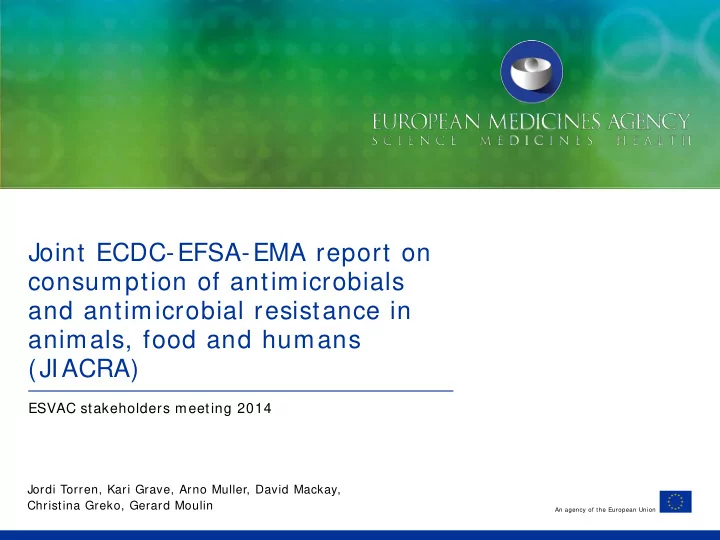

Joint ECDC-EFSA-EMA report on consumption of antimicrobials and antimicrobial resistance in animals, food and humans (JIACRA) ESVAC stakeholders meeting 2014 Jordi Torren, Kari Grave, Arno Muller, David Mackay, Christina Greko, Gerard Moulin An agency of the European Union
Request from the European Commission (2012) Communication from the Commission to the EP and the Council on the Action Plan against the rising threats from AMR Actions 9 & 10: 'Strengthen surveillance systems on AMR and antimicrobial consumption in human medicine (action no 9) and in animal medicine (action no 10) “The analysis should result in a joint report of the three agencies , with harmonised and transparent presentation of the data, to be produced at regular intervals. We consider it of utmost importance that the three agencies intensify their cooperation on surveillance of AMR and antim icrobial consum ption .” 1 JIACRA
Objective The cooperation aims to promote smooth and effective cooperation between the European Centre for Disease Prevention and Control (ECDC), the European Food Safety Authority (EFSA) and the European Medicines Agency (EMA) on integrated use and reporting of data on usage of, and resistance to, antim icrobial agents in hum ans, anim als and food in the European Union. This work is an essential part of the actions included in the Commission Communication on the Action Plan against the rising threats from Antimicrobial Resistance (http: / / ec.europa.eu/ food/ food/ biosafety/ antimicrobial_resistance/ index_en.htm) 2 JIACRA
Agreement between Agencies Include data obtained through the surveillance programmes coordinated by EMA, EFSA and ECDC. The respective surveillance netw orks of the agencies w ill be inform ed regularly. The European Union Reference Laboratory for AMR will be informed on the working process. The joint report is to be endorsed by EMA, EFSA and ECDC. Final version to be delivered to the Commission in 2014. The joint report will not substitute the current reports produced by the three agencies. 3 JIACRA
Composition of JIACRA The group is composed by members of the Agencies (EMA, EFSA and ECDC) and its experts. From the EMA the experts/ members are; G. Moulin, C. Greko, K. Grave, A. Muller and J. Torren. JIACRA is chaired by G. Moulin. 4 JIACRA
Characteristics of the future first report This first joint report is the first of a series of reports to be produced at regular intervals. Due to the complexity of the tasks and limited resources is not envisaged to produce them yearly, but on a multiannual basis. The early stage of maturity of some of the systems for collecting and analysing data is acknowledged. Is foreseen that in the future, as the work of each of the networks progresses towards a more detailed and accurate gathering and analysis of data, a more refined report will be produced. 5 JIACRA
Origin of the data • The ECDC has provided data on antimicrobial consumption in humans as well as resistance monitoring data on human isolates. • The EFSA data on monitoring antimicrobial resistance in food and animals • The EMA has provided data obtained from Member States on antimicrobial consumption in animals (ESVAC data). 6 JIACRA
Content of the report Description of the existing monitoring/ surveillance data • Characteristics of the ESVAC data collected • Veterinary antimicrobial agents included in the material • Population correction unit • Reporting and limitations of the data • Current AMR monitoring data in food producing animals and food • Further enhancement of AMR monitoring in food-producing animals and food in the EU 7 JIACRA
Content of the report • Complexity of addressing the link between consumption and resistance. • Overview of use of antimicrobials in animals and humans • Which AMs are used – comparison humans vs animals • Rational for the chosen combinations 8 JIACRA
Content of the report (cont). • Comparison of sales and resistance in animals • Comparison of antimicrobial use in human and resistance • Identification of critical points for integrated analysis of antimicrobial consumption and resistance obtained from monitoring/ surveillance data • Selected combinations of classes (or subclasses) of antimicrobials and bacteria 9 JIACRA
Key points • Collaboration of the 3 Agencies on sales and resistance to antimicrobials. • The report will identify areas for further collaboration and improvement. • To be published at the end of 2014 10 JIACRA
Key points (cont.) On going project, be patient 11 JIACRA
Recommend
More recommend